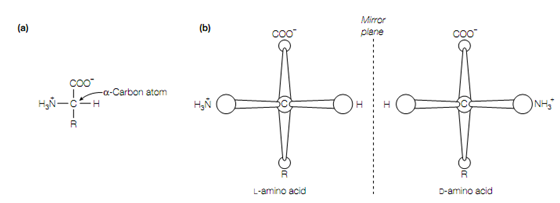Amino acids
Amino acids are the building blocks of proteins. From bacteria to humans, Proteins of all of the species are made up from the same set of twenty standard amino acids. with a primary amino group (-NH3) nineteen of these are α-amino acids and a carboxylic acid (carboxyl; -COOH) group associated to a central carbon atom, which is called the carbon atom (Cα) because it is adjacent to the carboxyl group .Also associated to the Cα atom is a hydrogen atom and a

(a) Fundamental structure of an amino acid showing the 4 different groups around the central α-carbon atom, (b) the 2 enantiomers of an amino acid
variable side-chain or 'R' group. The one exception to this common structure is proline, which contain a secondary amino group and is really α -imino acid. The names of the amino acids are frequently abbreviated, either to 3 letters or to a single letter. Therefore, for example, proline is abbreviated to Pro or P.